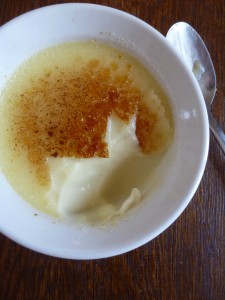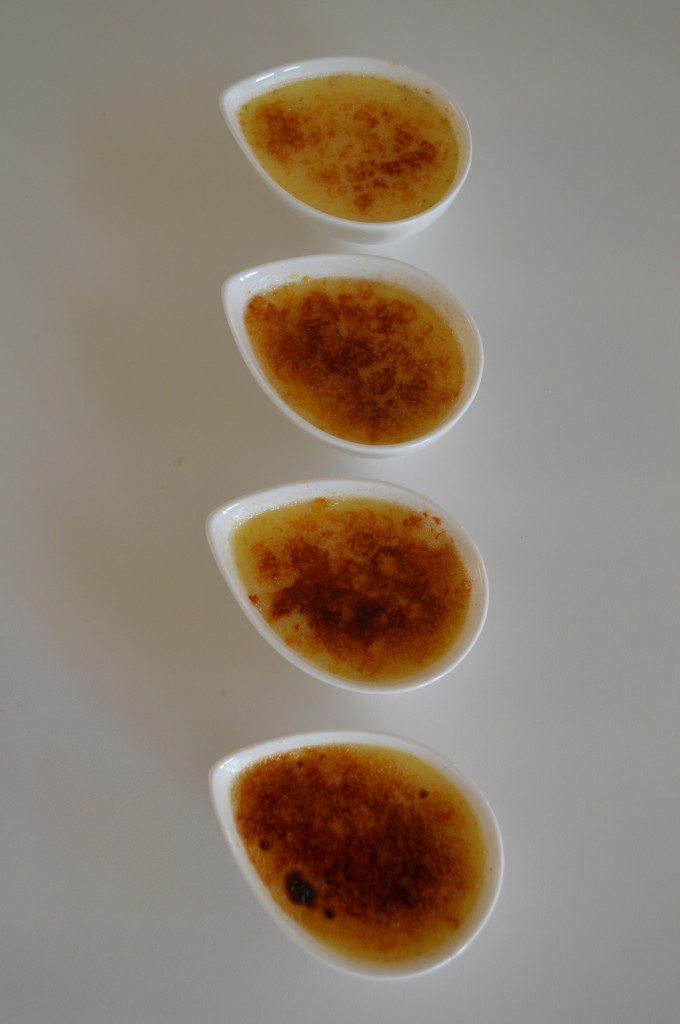 While crème brûlée is immediately identifiable by the crust of burnt sugar on top, the custard itself has a very particular consistency and flavour. Since it is eaten out of a ramekin, it can have a much softer, moister curd that, say, crème caramel, which is unmolded on to a plate and is therefore firmer, and eggier.
While crème brûlée is immediately identifiable by the crust of burnt sugar on top, the custard itself has a very particular consistency and flavour. Since it is eaten out of a ramekin, it can have a much softer, moister curd that, say, crème caramel, which is unmolded on to a plate and is therefore firmer, and eggier.
In fact crème brûlée used to be even more moist than it is now. According to Harold McGee, crème brûlée used to be completely liquid, like crème anglaise, and was poured into a very shallow dish, dusted with sugar, and burnt. Before blowtorches became the norm the burnt crust was made by taking a heavy, metal plate out of some very hot coals and holding it over the sugar.
I have worked for a handful of restaurants that offered crème brûlée. They each made it differently, but they were all very staunch and rigid in their methods, almost to the point of superstition.
I’d like to go over some of the details of a good crème brûlée.
The Recipe. 4:1:1 – dairy (equal parts heavy cream and whole milk), egg yolks, white granulated sugar
On flavouring. I guess there’s no reason you can’t flavour a crème brûlée with whatever you want: butterscotch, mint, orange, chocolate, quinoa, and so on.
But…
Imagine that you go see a show at The Starlite Room. You show up at 8 o’clock and drink $4 beers for a few hours. The featured act was supposed to come on at 10, but they stagger on just after midnight, and they all have sunglasses on. Now, if they play a good set and knock your socks off, then the sunglasses just make it that much cooler. If they don’t nail the set, then the sunglasses are obnoxious. What I’m trying to say is that if you can’t deliver a perfect crème brûlée with a silken mouthfeel, you have no business flavouring it with anything but vanilla.
Beating the eggs and sugar to ribbon stage? Completely unnecessary, as discussed in this post.
Cooking beforehand? Some folks cook the crème brûlée mix on the stove to thicken it, like crème anglaise, before transferring it to ramekins for baking. The truth is that pre-cooking on the stove is completely unnecessary. Simply scald the milk to infuse your chosen flavour, then slowly add to the sugar and egg yolks while whisking. Transfer to the ramekins and bake.
Water bath. Very necessary. Helps cook the custard slowly and evenly. Put the ramekins into a shallow roasting tray, then fill the tray with simmering water so that it comes halfway up the sides of the ramekins. Then the entire assembly can go into a moderate oven, say 325°F, but the effective cooking temperature will stay well below the boiling point of water, 212°F.
Wire rack or towel beneath the ramekins in the water bath. Placing a towel in the water bath under the ramekins is supposed to keep the ramekins away from the thermal vicissitudes of the metal tray. In reality it just inhibits the movement of heat around the ramekins. Wire racks, on the other hand, let heat flow evenly under and around the ramekins. Truthfully you can make superb crème brûlée without the use of either. I always put my ramekins directly on the bottom of the tray and the custard comes out uniformly cooked.
Covering the ramekins or the water bath with foil. Never, never cover the entire water bath with aluminum foil: covering will allow the water bath to come to a simmer, and the enclosed steam will raise the cooking temperature well above 212°F. The custard will cook quicker, but the window of perfect doneness will be very narrow, so you risk overcooking the custard and making it grainy.
The logic behind covering the bath is to keep the surface of the custard moist and prevent the formation of a dry skin. In my experience, baking custards in a conventional oven (ie. no convection fans) at moderate temperature (325°F) in a water bath, uncovered, does not develop a skin.
Crème brûlée as act of faith. People told me this a dozen times before I actually believed it: you have to pull the ramekins out of the oven before they are done. It’s like believing that Jesus saves, or walking through the wall at train station platform 9 3/4. You need to believe that they will finish cooking even after you remove them from the oven, even though it doesn’t make much sense.
Periodically jostle the ramekins during baking. Eventually the surfaces of the custard will move less like a liquid, and more like a very loose jelly. If you wait until the custard is entirely set before taking it out of the oven, the texture will be slightly grainy. The tricky bit is that different sizes and shapes of ramekins will all make the surface of the custard behave in different ways.
Torching. There is a wide range of opinions on the perfect brûlée colour and texture.
The colour, flavour, and texture of the topping are determined by how much sugar is placed on top, and how thoroughly and in what manner it is torched. I have worked at places that have you throw an entire crème brûlée out if you create any smoke. And I have worked at others that will not serve a crème brûlée that doesn’t have at least a few black freckles.
Have a look at the photo below. Let’s call the ramekin at the top of the page the first ramekin, the one at the bottom the fourth. If I was eating at a bistro and received the first ramekin I would not be upset. It is lightly coloured, and will offer a satisfying, delicately crisp contrast to the custard. It is, however, slightly anemic.
The second and third ramekins have more amber colour and offer a more robust crust, and more dark, burnt flavours.
The fourth ramekin is an example of the far end of acceptable crème brûlée crusts. It is mostly a deep amber colour, but has a few patches of black, truly burnt sugar.
